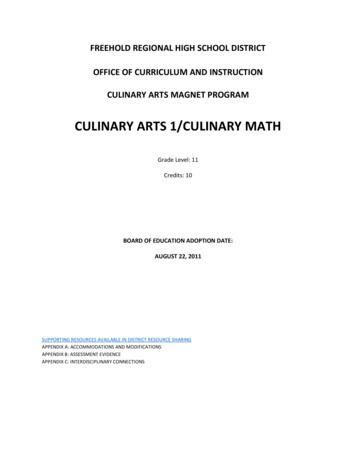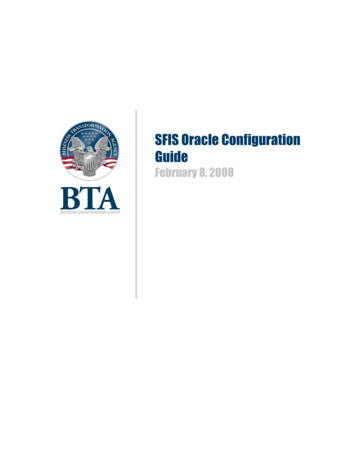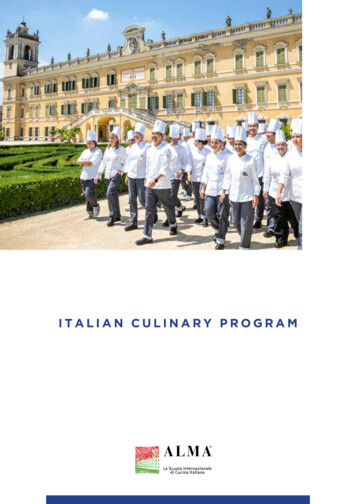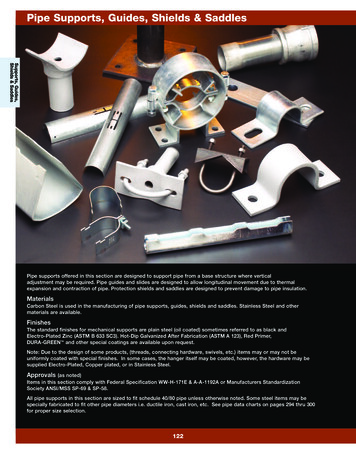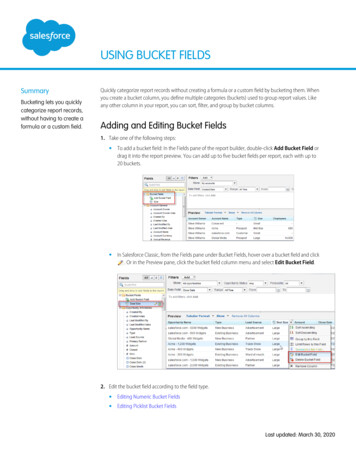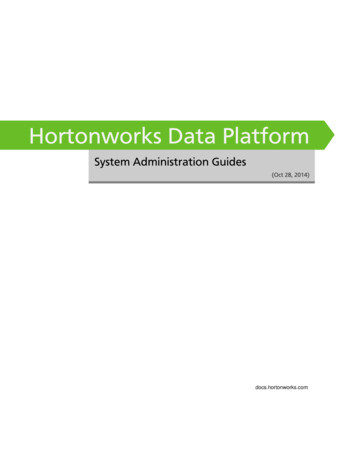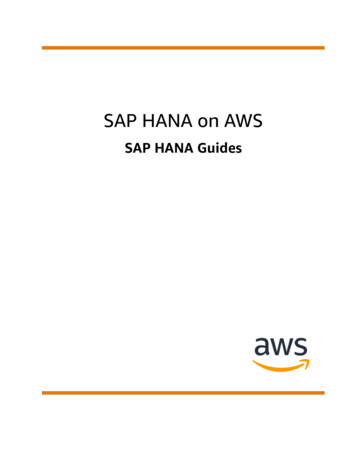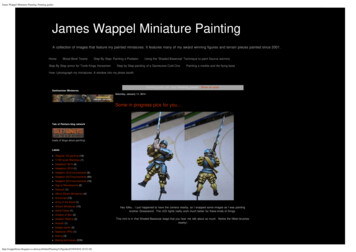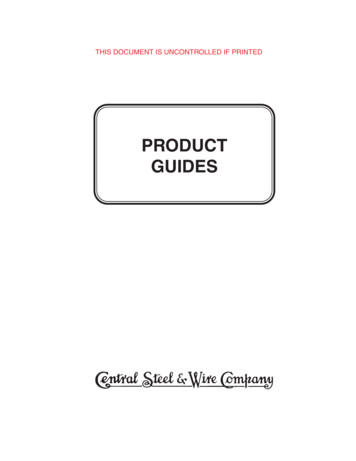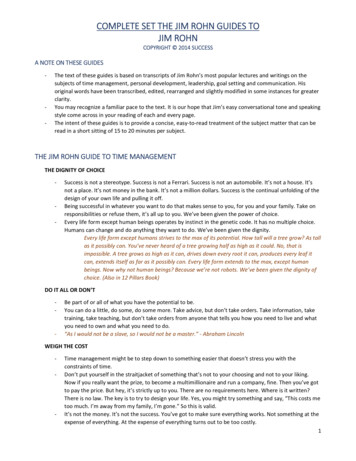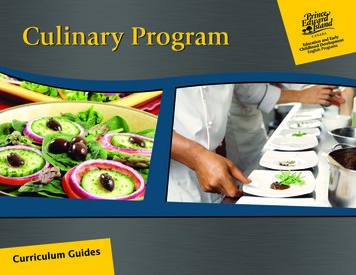
Transcription
AcknowledgmentsCurriculumCommitteeThe Department of Education and Early Childhood Development acknowledges the contributions of thefollowing in the development of the Career and Technical Education Skilled Trades curriculum guides.For contributing to the planning, writing, piloting, and implementation stages of the Culinary Skills CTE SkilledTrades curriculumFood Service Curriculum CommitteeSusan Yeo-Davidson - Westisle Composite High SchoolAnne Dixon - Charlottetown Rural High SchoolSharon Anderson - Montague Regional High SchoolBette Young - Kensington High SchoolJo-Ann MacKenzie - Bluefield High SchoolPam Good - Holland CollegeGary PykeSecondary Career and Technology/Trades Program Specialist, PEI Department of Education and EarlyChildhood Development (2005 - 2010)John StephensSecondary Career and Technology/Trades Program Specialist, PEI Department of Education and EarlyChildhood Development (2006 - 2012)For sharing curriculum documents, research, and knowledge that have guided the planning and developmentprocess for the PEI CTE Skilled Trades CurriculumNational Research Center for Career and Technical Education, University of Louisville (www.nccte.org)CULINARY SKILLS: PRINCE EDWARD ISLAND CAREER AND TECHNICAL EDUCATION CURRICULUM GUIDEi
ContentsCulinary ProgramIntroduction .1Background . 1Rationale . 1Vision . 2Program Design and Components .3Essential Graduation Learnings . 3General Curriculum Outcomes . 4Specific Curriculum Outcomes . 4Blooms Taxonomy . 5Achievement Indicators . 7Career and Technical Education Framework . 8CTE Culinary Skills Course Descriptions . 9Supporting Curricula . 11Accelerated Secondary Apprenticeship Program. 12Other Skilled Trades (Transferable Skills). 12Post-Secondary Opportunities . 12Cross-Curriculum Specific Items.13The Senior High School Learning Environment . 13Safety . 13Meeting the Needs of All Students . 14Engaging the Students . 15Gender-Inclusive Curriculum . 16Avoid Stereotypical Assumptions . 16Model Inclusive Language . 17CULINARY SKILLS: PRINCE EDWARD ISLAND CAREER AND TECHNICAL EDUCATION CURRICULUM GUIDEii
Valuing Social and Cultural Diversity . 18Supporting EAL Learners . 18Role of Parents and Guardians . 19Links to the Community . 19Education for Sustainable Development . 20Teaching Strategies .21Methodology . 21Organization/Management of the CTE Facility . 22Safety in Career and Technical Education . 23Safety Code of Conduct . 23CTE Teaching Strategies Graphic. 24Project Based Learning . 25Community-Based Learning . 27Interactive Instruction . 27Indirect Instruction . 27Direct Instruction . 27Literacy . 28Numeracy . 30Assessment .32Introduction . 32Assessment . 32CTE Assessment Strategies Graphic . 42Skills Performance . 43Pencil/Paper . 44Teacher Observation . 45Self/Peer Assessment. 46Life Work Portfolio. 47CULINARY SKILLS: PRINCE EDWARD ISLAND CAREER AND TECHNICAL EDUCATION CURRICULUM GUIDEiii
Foods and Nutrition – FDS421A .49Rigor and Relevance Analysis . 51FDS421 Curriculum Guide . 54Culinary Skills A – CUL801A .87Rigor and Relevance Analysis . 89CUL801A Curriculum Guide . 92Culinary Skills B – CUL801B .125Rigor and Relevance Analysis . 127CUL801B Curriculum Guide. 130Appendices .163Appendix A – Classroom Management . 165Appendix B – Literacy Strategies. 173Appendix C – Numeracy Strategies . 187Appendix D – Outcome Reference Chart . 213CULINARY SKILLS: PRINCE EDWARD ISLAND CAREER AND TECHNICAL EDUCATION CURRICULUM GUIDEiv
This page has intentionally been left blank.vi
IntroductionBackgroundThe Department of Education and Early Childhood Development has developed a Career and TechnicalEducation (CTE) curriculum framework following recommendations found in the Trades Strategy Report,May 2005.This curriculum provides opportunities for a student to achieve relevant and rigourous skill basededucation. When combined with other high school courses, the CTE Culinary Skills curriculum preparesstudents for post-secondary education related to culinary arts, food service and/or food production andprepares them with practical skills needed to start a career in the food service industry.The student may earn credits towards high school graduation and accumulate apprenticeship hours leadingto Red Seal certification (Cook).This document assists educators, students, and others to construct meaningful learning experiences incareer and technical education (CTE).RationaleThe Career and Technical Education (CTE) curriculum is designed to provide students with opportunitiesto enrol in relevant programming leading to post-secondary training, education, and technical certification(when available).The CTE curriculum will help to address the current and future needs by contributing to the development ofan adequate supply of skilled workers on PEI.The CTE curriculum will develop the students’ skills, knowledge, and competencies within a careerenvironment. The curriculum is designed to enhance the students’ literacy and numeracy skills, and todevelop Essential Skills and Employability Skills relevant to the workplace and lifelong learning.The curriculum explains the value and process of the apprenticeship system, the value of post-secondaryeducation, and the logistics of eventual certification.Students will be encouraged to take pride and ownership in their learning journey though the developmentof a Personal Skills Logbook and Learning Journal to support their Lifework Portfolio.CULINARY SKILLS: PRINCE EDWARD ISLAND CAREER AND TECHNICAL EDUCATION CURRICULUM GUIDE1
The course offerings will allow flexibility within the pathway for students to explore and customize theirlearning plans to meet their personal needs and future plans.Students may enrol in complementary applied courses in math, science, design, and cooperative educationthat will further enhance their learning experience.Students may also choose to enrol in the Accelerated Secondary Apprenticeship Program (ASAP).VisionThe vision for Career and Technical Education in Prince Edward Island fosters the development of alllearners as technologically literate and capable citizens who can develop, implement, and communicatepractical, innovative, and responsible technological solutions to problems.Career and Technical Education courses are designed to achieve the general curriculum outcomes (GCOs)for Technology Education:A. Technological ResponsibilityB. Technological SystemsC. History and Evolution of TechnologyD. Technology and CareersE. Technological Problem SolvingCULINARY SKILLS: PRINCE EDWARD ISLAND CAREER AND TECHNICAL EDUCATION CURRICULUM GUIDE2
Program Design and ComponentsEssentialGraduationLearningsThe CTE curricular program design and components are supportive ofthe framework incorporated in the Atlantic Canada Technology EducationFoundation Document.Essential Graduation LearningsEGLsGeneral Curriculum OutcomesEssential Graduation Learnings (EGLs) serve as a framework for the(GCOs)curriculum development process and are statements describing thebroadsubjectexpectationsknowledge, skills, and attitudes expected of all students who graduate fromhigh school. Achievement of the EGLs will prepare students to continue tolearn throughout their lives. These learnings describe expectations not inSpecific Curriculum Outcomest
Susan Yeo-Davidson - Westisle Composite High School Anne Dixon - Charlottetown Rural High School Sharon Anderson - Montague Regional High School Bette Young -
